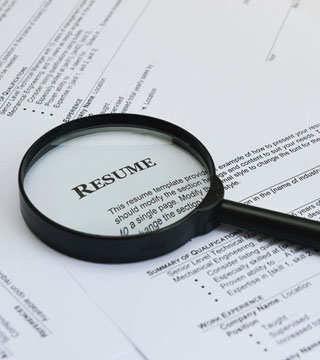What to Put in a Resume

Make sure your resume contains everything the employer needs to be convinced that you are a good match for the position.
A complete resume includes the following sections. Learn other basic resume rules.
Contact Information
Contact information should be placed on top of your resume. It should be easy and quick to read.
- Name and address
- E-mail address. Avoid using unprofessional e-mail address such as banana_buns or hottie4u.
- Phone numbers. Remember to check your outgoing voice mail message for loud background music, slang, or improper language.
- Include the address for your website or online portfolio.
Sample Contact Information
Elizabeth (Lisa) Smith
1443 Minnesota Lane
City, Minnesota 55555
651.123.4567 (home) * 612.123.4567 (cell)
esmith@email.com
http::⁄⁄www.esmith.com
Objective Statement
An objective statement clearly states the purpose of your resume. Not every resume has this. Use it to let an employer know your specific job or career goal. Tailor your objective to the type of job to which you're applying. If you decide not to include it in your resume, be sure to state an objective in your cover letter.
Example: "To obtain a challenging position as an administrative assistant in the financial services industry."
Summary Statement
A summary statement grabs the employer's attention by highlighting your qualifications. It is used in place of an objective statement. An employer may not read your entire resume. A summary will give them a snapshot of your work experiences, achievements, and skills. To be effective, it should be very brief (4-5 lines of text). It should also be written for the position you are applying for. Use keywords and resume verbs when creating your summary statement.
Example: "Resourceful planner/coordinator with extensive knowledge of inventory control and online inventory systems. Recognized by management for innovation and initiative in implementing JIT techniques as well as interdepartmental communications and supervisory skills."
Employment History
You can present your work experience in a variety of ways. The most straightforward way is the chronological format. List your current or most recent job, and work backwards in time. Include your job title, your employer's name, the city and state in which it is located. Also list the start and end dates (month and year) of your employment. For each position, add a summary of your responsibilities and accomplishments.
Administrative Assistant (January 2009-Present)
ABC Financial Services, Minneapolis, MN
•Supported three department managers with word processing, scheduling, and filing.
•Generated reports to summarize monthly activities.
Learn about the three types of resume formats (chronological, functional, and combination resumes) and resume keywords and action verbs.
Education
List your educational accomplishments, starting with your most recent or highest degree. Include the name and location of the institution attended, your degree, and field of study/major.
Other Information
Include relevant information that relates to the job to which you are applying. This may include memberships to organizations, volunteer work, military experiences, computer skills, awards, and hobbies. Avoid mentioning religious, political, or controversial affiliations unless they directly relate to the job you want.
Don't include references on your resume. Employers assume that you can provide them with these. Learn how to select references.
Source: Creative Job Search, Minnesota Department of Employment and Economic Development.


